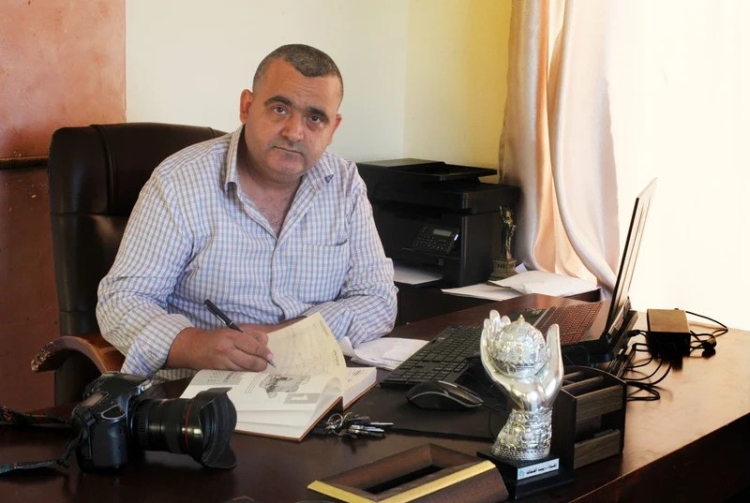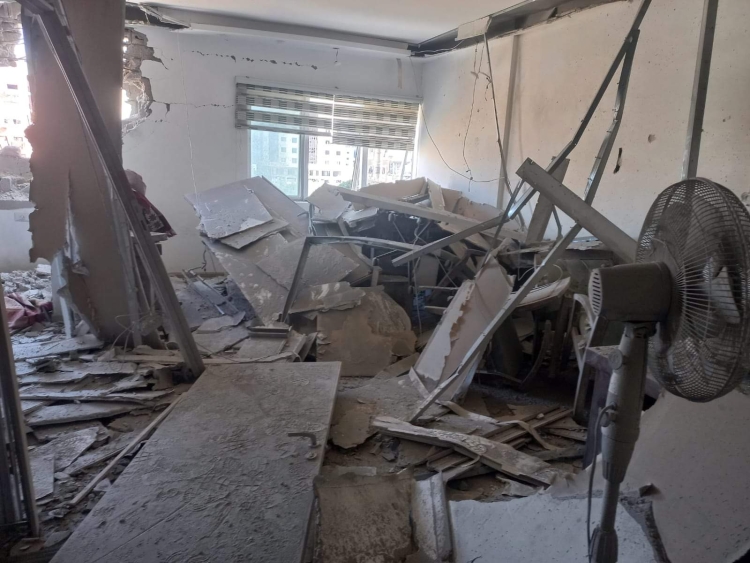The email from veteran journalist Naaman Ashtawy began with an apology.
“Sorry for the delay [in responding] due to being on alert about moving out of Al Aqsa Hospital where we operated since last October. We are on another difficult journey to nowhere,” Ashtawy wrote on Aug. 28. “We’re still considering all options, while trying to keep our operations going as much as possible. Absolutely no place in Gaza is safe.”
The Associated Press reported that Al Aqsa, one of Gaza’s last functioning hospitals, was emptying out as Israeli forces drew near. Ashtawy and his team once again were on the run.
Earlier this year, Ashtawy was wounded by shrapnel in his face, arm and leg during a bombing incident near a hospital where he was working. Two members of his team also were injured. They have since recovered and are back in the field. Cameras, computers and other equipment were lost in the attack.

These journalists, many of them freelancers, work in one of the most dangerous spots on earth for the media. According to the Committee to Protect Journalists (CPJ), 116 journalists and media workers were among the more than 42,000 killed since the war began, making it the deadliest period for the press since CPJ began keeping track in 1992. Most of the journalists killed have been Palestinians.
ICFJ has joined press freedom organizations in calling for Israel to halt the killings of journalists, who are civilians under the law, and investigate cases of journalists killed by their forces.
Ashtawy, the director of APA Images, a local photo agency, is part of ICFJ’s global network. Looking to create an up-to-date digital system, in May 2023, he took part in ICFJ’s Elevate, a program designed to help owners of small- and medium-sized media outlets develop their business skills. Joining him was Ahmed Faud, APA’s chief operating officer.
APA’s teams include reporters, editors, videographers and photographers. They have been on the move since their office was destroyed in the bombing. Earlier this year, Faud fled to the United States with his family and remains in close contact with Ashtawy by phone and email.

Israel has banned outside journalists from entering Gaza, except for limited trips arranged by the military. Dozens of media and civil society organizations, including ICFJ, have urged Israel to end the restrictions.
“The ban means that Palestinian journalists are the only source of news from the ground in Gaza, and at the same time, they are struggling to survive and keep their families safe,” said ICFJ President Sharon Moshavi. “The situation is extremely harrowing, beyond description.”
For Gaza’s journalists, there is little relief in sight.
“It is increasingly difficult for journalists in Gaza to find a safe location,” said CPJ Middle East and North African expert Mohamed Mandour. “Many have reported moving from one place to another in search of safety, and some have been killed during their evacuations.”
Journalists face a constant struggle to find internet access to share their stories and images with the world and have been attacked by drones while trying to get a connection, said Mandour. Most media offices in Gaza have been destroyed.
Report from the front lines
Following are excerpts from a dispatch Ashtawy sent in August describing life in the line of fire in Gaza. His comments have been lightly edited for clarity.
“Journalists in Gaza play a tremendous role in showing the world the horrors of this war and they are paying a price,” wrote Ashtawy. “The videos and photos circulating around the globe are a product of sweat and blood, long nights and days of work while hungry, thirsty, and no proper equipment or safety vests. Many lost their laptops and cameras when media offices were bombed. We are exposed to extreme danger without protection, no armor, no helmets.
“The physical and psychological burdens are extreme, between frequent moving and forced evacuation, looking for safety for our families and everybody around us, searching for basic needs such as food, water and medicine, keeping our coverage going and overall surviving the day.”
Ashtawy described the challenges: “For transportation, our team members walk for miles, ride bicycles, donkey or horse carts, or share car rides, due to expensive and scarce gasoline. We look for alternatives, such as using cooking oil instead of fuel in some cases. Our website, the gateway to the outside world, has been frequently attacked by hackers. We managed to secure it to some extent, and we are working on alternatives to serve our clients and audience.
“Electricity, internet and mobile services are major obstacles. We check for available electricity, powered by solar panels or storage batteries. Sometimes we get lucky; sometimes we do not. For mobile and internet services, we mainly depend on local internet providers, when available, or international e-sims, which aren’t available all the time.
“Many times, the coverage is shocking when someone we know, a family member, a friend or colleague, has been injured or killed. Journalists are targeted, and their families also, which is a major concern for us. This is a difficult mission, but we stand firm in doing our professional duties,” Ashtawy wrote as he began yet another evacuation.
Struggle for survival
Journalists form tent communities, often in or near a hospital, for a modicum of safety. The journalists share sparse resources and information.
“For them, [the tents] are home for the time being,” said APA’s Ahmed Faud. “When it comes time for them to go to the field, they wish each other well, because who knows what could happen to any one of them. These tents are the last shelter for some who leave to cover the news and never come back or end up badly injured.
“The worst part, you find your colleague, who you were with just minutes before going into the field, returning to the hospital in an ambulance as a dead body, due to an Israeli attack. Unfortunately, such shocks and traumas have become part of daily life for Gaza’s journalists,” said Faud.
This article was originally published by IJNet's parent organization, ICFJ.


